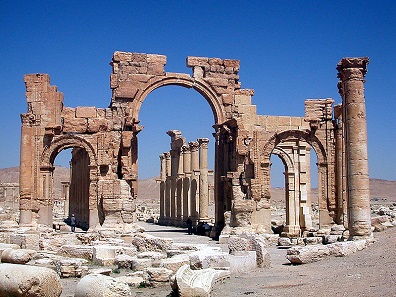by Annika Backe
March 24, 2016 – The terrorists of the Islamic State (IS) are systematically destroying ancient buildings in Syria. The pearl of the desert, Palmyra, was particularly hard hit. In 2015, the IS blew the temples of Bel and Baal-Shamin apart, thus irretrievably erasing cultural heritage of mankind.
Hadrian’s Gate at Palmyra that blown was up by IS terrorists in autumn 2015. Source: Wikicommons.
As a gesture of defiance against the terror, foreign institutions are currently recreating what is lost, using state-of-the-art technology such as the world’s biggest 3D printer in Shanghai, China. Drawing on dozens of photographs, computer models are made which serve as a basis to reconstruct the ancient monuments. According to the Institute for Digital Archaeology, these replicas will be on public display in Trafalgar Square in London and in Times Square in New York as of April 19, 2016.
The Institute for Digital Archaeology (IDA) is a joint venture between the Universities of Harvard and Oxford as well as Dubai’s Museum of Future. Specialized in the use of 3D technology for conservation and restauration projects, IDA has distributed 3D cameras throughout conflict zones in the Middle East, to take photographs of threatened buildings.
What pleases one researcher annoys another one. In an article published in the newspaper “Die Welt” on October 5, 2015, Prof Dr Friederike Fless, President of the German Archaeological Institute (DAI), warned against creating an “Archaeological Disneyland”. Rather, she considered it more important to establish co-operations with the academic colleagues in Syria, to train students in the protection of cultural heritage, and to organize bilateral learning and restoration programs. By generating more jobs in Syria, such efforts would be much more effective and sustainable than any 3D project could ever be.
Surely nobody doubts that sustainable efforts in and for Syria are currently called for. However, a project as this one does not exclude co-operations with the Syrian researchers. In order to reach the general public, it takes vividness. The main goal is to raise everybody’s awareness of the fact that Syrian cultural heritage falls victim to IS’ vandalism – every single day.
The main information for this contribution was taken from an article of the Committee for Cultural Policy from January 2, 2016.
This is the website of the Institute for Digital Archaeology.
CoinsWeekly reported on IS destroying monuments in Syria here and here.
Please find the (German) article of Prof Friederike Fless here.
This CoinsWeekly article tells you more about France offering asylum to endangered Syrian art.
And if you want to contribute to the virtual remodeling of Palmyra, you can upload your photos to #NEWPALMYRA.




